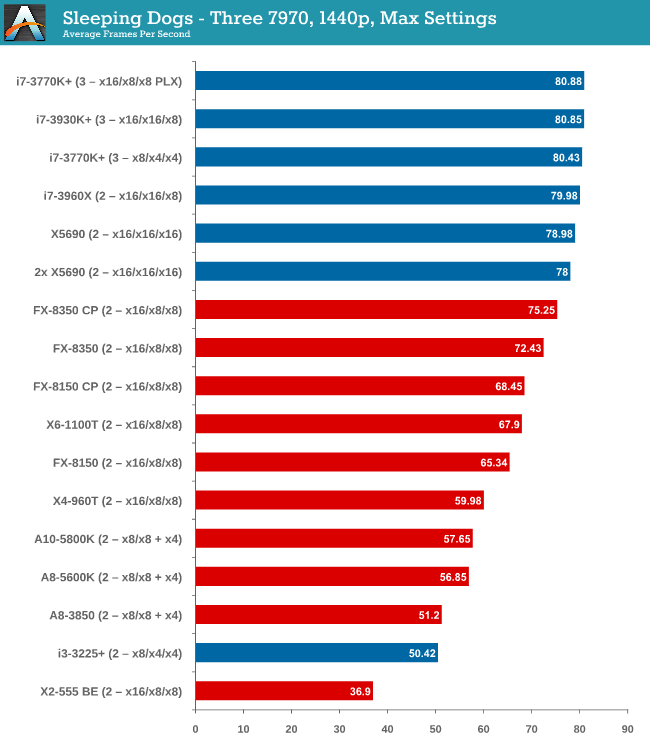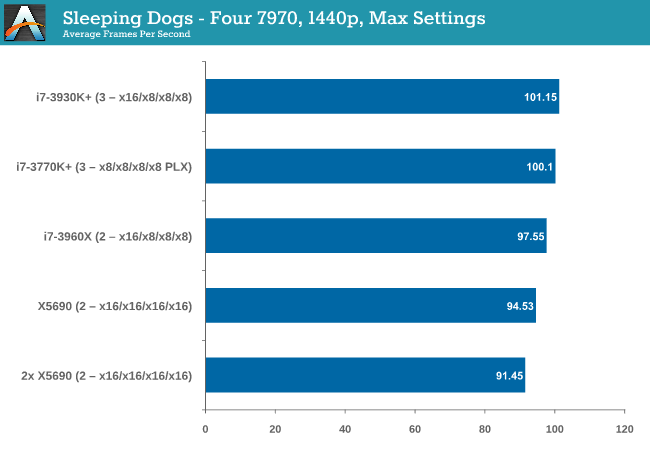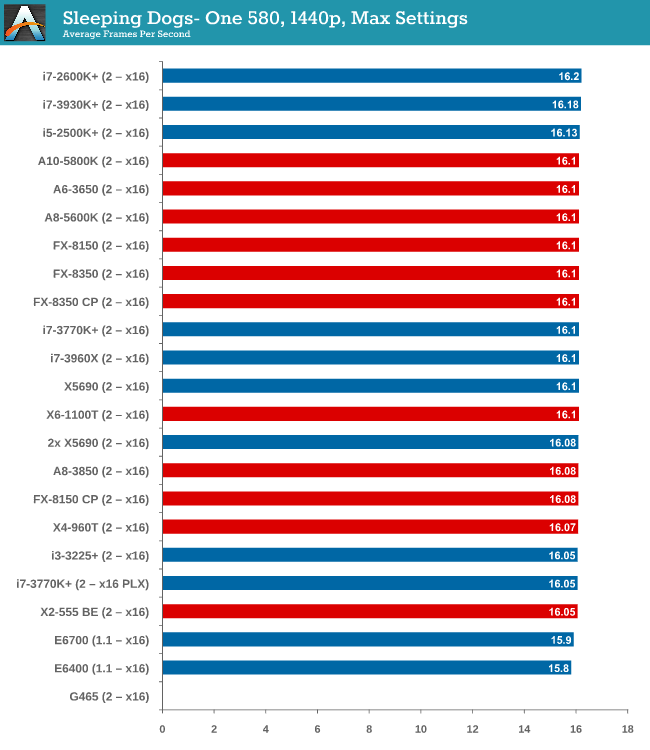Choosing a Gaming CPU: Single + Multi-GPU at 1440p, April 2013
by Ian Cutress on May 8, 2013 10:00 AM ESTSleeping Dogs
While not necessarily a game on everybody’s lips, Sleeping Dogs is a strenuous game with a pretty hardcore benchmark that scales well with additional GPU power. The team over at Adrenaline.com.br are supreme for making an easy to use benchmark GUI, allowing a numpty like me to charge ahead with a set of four 1440p runs with maximum graphical settings.
One 7970

Sleeping Dogs seems to tax the CPU so little that the only CPU that falls behind by the smallest of margins is an E6400 (and the G465 which would not run the benchmark). Intel visually takes all the top spots, but AMD is all in the mix with less than 0.5 FPS splitting an X2-555 BE and an i7-3770K.
Two 7970s

A split starts to develop between Intel and AMD again, although you would be hard pressed to choose between the CPUs as everything above an i3-3225 scores 50-56 FPS. The X2-555 BE unfortunately drops off, suggesting that Sleeping Dogs is a fan of the cores and this little CPU is a lacking.
Three 7970s

At three GPUs the gap is there, with the best Intel processors over 10% ahead of the best AMD. Neither PCIe lane allocation or memory seems to be playing a part, just a case of threads then single thread performance.
Four 7970s

Despite our Beast machine having double the threads, an i7-3960X in PCIe 3.0 mode takes top spot.
It is worth noting the scaling in Sleeping Dogs. The i7-3960X moved from 28.2 -> 56.23 -> 80.85 -> 101.15 FPS, achieving +71% increase of a single card moving from 3 to 4. This speaks of a well written game more than anything.
One 580

There is almost nothing to separate every CPU when using a single GTX 580.
Two 580s

Same thing with two GTX 580s – even an X2-555 BE is within 1 FPS (3%) of an i7-3960X.
Sleeping Dogs Conclusion
Due to the successful scaling and GPU limited nature of Sleeping Dogs, almost any CPU you throw at it will get the same result. When you move into three GPUs or more territory, it seems that having the single thread CPU speed of an Intel processor gets a few more FPS at the end of the day.










242 Comments
View All Comments
aburhinox - Wednesday, May 8, 2013 - link
This is a great article to compare cpus across multiple gpus. I'd also be curious to see how different GPUs scale. I'd like to see if a single $400 card is better than 2 $200 cards. I'm going to say that given the choice between one or two $400 cards, two is better than one. Going to the extreme would get you to ask if you want to go crazy, if four $100 cards is better than 1 $400 card. That would probably be going too far since you have to end up with expensive motherboards to support four gpus. But I think that would make a useful article about gpus.dwatterworth - Wednesday, May 8, 2013 - link
Thank you for putting the DP Xeon platform in. I imagine it is a niche market but a platform parallel to that in an older generation would be a huge help. I have an aging LGA 771 Asus Z7S-WS board with (2) e5472 procs with (1) 7950 w/boost. The system was built for 3D rendering and architectural work and as 2 systems are not affordable, this became my gaming machine as well. Other than putting my own benchmarks up against what I can find here or other sites it is very hard for me to decide when and to what to upgrade. I greatly appreciate the Xeon inclusion on this as there are some (few?) who fall into the work + play on a single machine scenario.xinthius - Wednesday, May 8, 2013 - link
You, my friend, just made me laugh well and truly, thank you."his intelligence will diminish gradually." Speaking from experience I see?
kyuu - Wednesday, May 8, 2013 - link
Maybe this is a dumb question, but shouldn't the Core Parking updates also be beneficial to the APUs? They're still using the same module architecture as the FX chips.IanCutress - Wednesday, May 8, 2013 - link
That's planned for the next update, after Haswell launch. At the time I completely forgot and went on to the next platform. Need to pull out the FM2 test bed, install an OS and retest them - another day of testing at least (!). But it's on the 'to do' list.Ian
kyuu - Wednesday, May 8, 2013 - link
Cool, thanks for the reply Ian.antonyt - Wednesday, May 8, 2013 - link
This analysis is great! And extremely useful for anyone contemplating a gaming build in the near future (as I am). I look forward to seeing your updates and more articles like this.Btw, minor typo ("future") at the very end--"but we hope on expanding this in the fuiture."
IanCutress - Wednesday, May 8, 2013 - link
Fixed the typo, cheers :)felang - Wednesday, May 8, 2013 - link
Only if you plan to play single player games onlyxinthius - Wednesday, May 8, 2013 - link
You agree with the fact your intelligence has diminished? Okay.I would LOVE to see you design a microprocessor as complex as one of AMDs. Their processors actually perform admirably in highly threaded workloads, while their current architecture is weak in the IPC department. Their CPUs are by no means weak and should still be recommend in some circumstances, such as their APU range. Please try and post intelligently, I know it's hard for you.